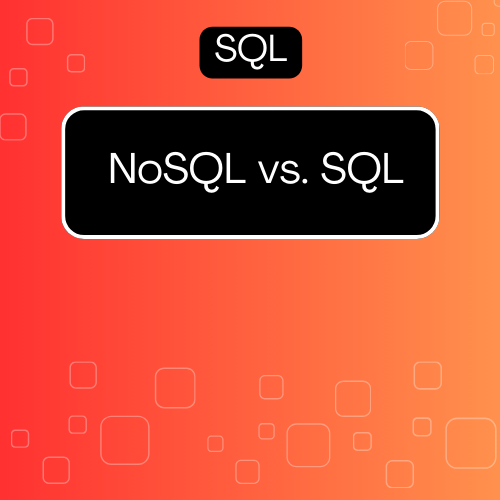So, when I started learning SQL, I came across terms like “database,” “DBMS,” and all that. Then I stumbled upon something called NoSQL. At first, I thought, “No SQL? Does that mean we’re not using SQL at all?” Let me clarify that for you. While SQL and NoSQL might sound contradictory, they actually represent two different ways of managing data, each with its own strengths.
What Are SQL and NoSQL?
SQL (Structured Query Language) databases are your traditional relational databases. They organize data into tables with a fixed structure. Think of it like a well-organized filing cabinet. SQL is great for structured data and is commonly used in applications like banking or corporate systems where everything needs to be in order.
Now, NoSQL (Not Only SQL) databases, on the other hand, are a bit more flexible. They can handle unstructured and semi-structured data, which means you can work with all sorts of formats. Imagine a messy room where you can just toss things around—NoSQL is perfect for that kind of scenario. It’s great for applications that need speed and scalability, like social media platforms or real-time analytics.
Key Differences Between SQL and NoSQL
Now, let’s break down some key differences between SQL and NoSQL to make things clearer:
- Data Structure: SQL uses a set structure with tables and relationships. It’s like a well-defined recipe where you know exactly what goes where. NoSQL allows for various data models, like key-value pairs or documents, making it more adaptable to different needs.
- Scalability: SQL databases scale vertically, meaning you add more power to a single server. NoSQL databases scale horizontally, allowing you to spread data across multiple servers easily. It’s like adding more rooms to a house versus building a whole new house!
- Transactions: SQL databases are all about data consistency through something called ACID compliance. NoSQL may offer eventual consistency, which is quicker but less strict—like saying, “I’ll get it right eventually.”
- Query Language: SQL uses a standard query language that everyone knows. NoSQL databases often have their own ways of doing things, with different APIs or query styles.
When to Use SQL
So, when should you go for SQL? It’s a solid choice when:
- You need to perform complex queries while ensuring strong data consistency. Think of it as making sure all the details in your report match up perfectly.
- Your data structure is clear and won’t change often. If you have a specific way you want to organize things, SQL is great for that.
- You’re dealing with relational data, where connections and relationships are important. It’s like having a family tree where everyone is linked.
When to Use NoSQL
Now, let’s talk about when NoSQL is the way to go:
- If you’re working with large amounts of unstructured or changing data, NoSQL shines here. It’s perfect for when you’re collecting lots of varied information.
- You need to develop and deploy quickly as your user base grows. NoSQL allows for fast changes, making it easier to keep up with demand.
- Your application requires flexibility in how data is stored. If you want to mix and match data types without a strict structure, NoSQL gives you that freedom.
So, can NoSQL handle tables?
The short answer is: not in the traditional sense. Let me explain.
While SQL databases are built around the idea of tables with rows and columns, NoSQL databases take a different approach. They’re designed to be more flexible and can store data in various formats, which might not include tables at all.
Here’s a Breakdown:
- Document Databases: These NoSQL databases store data in documents, typically using formats like JSON or BSON. Each document can have a different structure, so you won’t find rigid tables here. However, you can think of a document as a flexible row that can include multiple fields, similar to a table but without the constraints.
- Key-Value Stores: In this type, data is stored as a collection of key-value pairs. There’s no concept of tables; instead, you retrieve data based on a unique key. It’s like a big dictionary where you look up a word (the key) to find its definition (the value).
- Column-Family Stores: These databases, like Cassandra, store data in columns rather than rows. Each column family can hold multiple rows, but unlike SQL, you don’t have to define all columns in advance. This allows for more flexibility, but it’s still not the same as traditional tables.
- Graph Databases: These databases focus on relationships between data points and are structured as nodes and edges rather than tables. They’re great for representing complex relationships but completely ditch the table format.
So, to sum it up:
NoSQL databases can manage data in a way that fits the application’s needs, but they don’t rely on traditional tables like SQL databases do. Instead, they offer various structures that can be more adaptable to the diverse types of data you might encounter.
If you’re dealing with structured data that fits neatly into tables, SQL might be the way to go. But if your data is unstructured or you need flexibility, NoSQL could be your best bet!
Conclusion: Choosing the Right Database for You
In the end, choosing between SQL and NoSQL depends on what you need for your project. Both have their advantages and downsides, and making the right choice can really impact how your application performs.
So, are you ready to boost your database skills? Whether you decide to stick with SQL for its structure or venture into NoSQL for its flexibility, knowing when and how to use each will set you up for success in the data-driven world.
